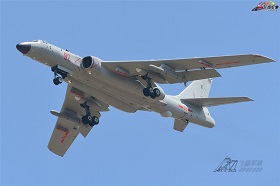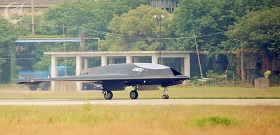China’s Air Force: from Shield to Sword
Model of J-31 fighter, Aviation expo in Beijing
(no votes) |
(0 votes) |
Research Fellow at the Primakov Institute of World Economy and International Relations under the Russian Academy of Sciences, RIAC expert
The Chinese air force is relatively young, but one of the biggest and strongest in the world. It has been developing extremely rapidly over the last two decades and is now approaching a decisive point which will be vitally important for China’s future potential to project its power far beyond its borders.
The Chinese air force is relatively young, but one of the biggest and strongest in the world. It has been developing extremely rapidly over the last two decades and is now approaching a decisive point which will be vitally important for China’s future potential to project its power far beyond its borders.
The People’s Liberation Army Air Force (PLAAF) of today traces its history back to the small aviation units of the Red Army in the period 1930–40 [1]. The communist forces made very limited use of aircraft in the civil war and the fight against the Japanese aggressors, since most of the trained personnel and equipment was controlled by Chiang Kai-shek’s central government, and aviation-related foreign aid, including that from the USSR, mostly went to him. After Chiang Kai-shek’s defeat in the civil war, however, a significant number of the air force personnel went into exile, making today’s Taiwanese air force [2] the legal successors to the history of China’s pre-communist air force.
The “People’s Air Force” was officially created only in the middle of 1949 [3]. It was manned by Chinese pilots who had crossed over to the communists, while Soviet instructors and even Japanese prisoner-of-war “volunteers” helped with training. Equipment was sourced from wherever it could be found, most of it Japanese, left behind by the occupying forces, or captured from the Kuomintang.
The primary objective of the PLA – to raise the Chinese air force to a modern global level worthy of a superpower – was essentially achieved.
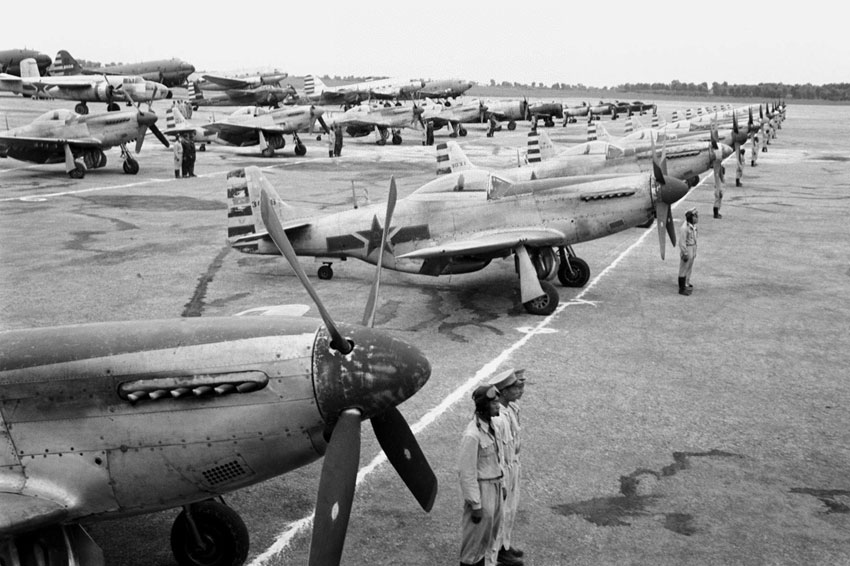
As a result the profile of the PLAAF was quite extraordinary – at its first air display, on 1 October 1949 (to mark the formation of the PRC), the young communist republic’s air force was represented by American Mustang fighters and C-46 Commando transport aircraft, British Mosquitoes, and a few American-made light trainers. Large-scale supplies of Soviet aircraft began only at the end of 1949.
The subsequent history of the Chinese air force can be divided into four stages. The first, its establishment, lasted until the beginning of the 1960s. During this time, thanks to the efforts of the USSR, the PLAAF [4] was transformed from a semi-partisan unit into a major force with serious combat experience and equipped with modern aircraft. Chinese pilots took part in combat against aircraft of the coalition of multinational forces during the Korean War of 1950–53, including in conjunction with Soviet pilots in the latest MiG-15 jet fighters. The end of the war in Korea was followed by the Taiwan Strait Crises, which saw major air battles between the former compatriots. During these, both sides operated the latest equipment supplied by their “suzerains”, including the first combat use of air-to-air guided missiles [5]. The USSR not only supplied its own manufactured aircraft but also helped to set up production in China of MiG-17 and MiG-19 fighters, Il-28 bombers, An-2 transport planes and many other aircraft.
In recent years the PLAAF has continued to develop rapidly and has entered a new stage in a number of areas.
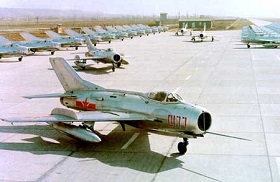
J-6 fighters (chinese version of the MiG-19), 1970th
The question of dependence on Russia is probably the most pressing one for China, driven by memories of the blow that was dealt by the break in relations with the USSR.
The second stage, which was long and difficult, began with the break in relations with the USSR. As a result of this confrontation the PRC received only part of the documentation and equipment required to start production of some of the latest aircraft, such as the MiG-21, the Tu-16 and the An-12. Without the aid of Soviet specialists, and in the context of the Cultural Revolution, it took decades to fully deploy this equipment. The air force continued to be based on copies of the MiG-17 (the J-5), the MiG-19 (J-6) and the Il-28 (H-5), which was unsatisfactory for a serious military power even in the 1960s, never mind later. By the end of the 1970s and 1980s, when China managed to get the J-7 (a copy of the MiG-21) and the H-6 (a copy of the Tu-16) into really large-scale production, the planes were also becoming very obsolete. Significant in terms of numbers of aircraft but with a level of equipment dating back to the start of the Cold War, at that time the PLAAF could offer only limited resistance to a more high-tech adversary and was totally unsuited to offensive operations. The fear of high losses meant they were not fully brought into operation even during the war with Vietnam in 1979.
The PRC’s air force began to overcome its technical backwardness with the thaw in relations with the West and the USSR/Russia. Active military-technical cooperation with Western countries in the 1980s was short-lived, and abruptly reduced after the events in Tiananmen Square in 1989, but China obtained a number of advantages from it, including relatively modern specimens of avionics and engines, assistance from foreign engineers in developing the J-7 family (which would later lead to the creation of the modern JF-17 lightweight fighter for export), and documentation for the Israeli-American Lavi fighter [6]. A truly new stage in the development of the PLAAF, however, is linked with the thaw in relations with Moscow. In the final years of the USSR’s existence China was offered the latest MiG-29 and Su-27 fourth-generation fighters, and after sizing them up the Chinese chose the latter. Major contracts followed, first for finished aircraft (78 during the 1990s) and then to set up licensed assembly of 105 aircraft, with an option for a further 95. The Su-30MKK, more adapted for strikes against land and maritime targets, was specially developed for China, together with its later variant the Su-30MK2 (a total of 100 aircraft were supplied in the first half of the 2000s).
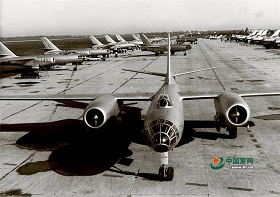
H-5 bombers (chinese version of the Il-28), 1970th
Development of the J-7 family continued – the MiG-21 was produced for the PLAAF until the middle of the 2000s, and the latest export contract was to supply planes to Bangladesh in 2013. China has started production of the new J-10 lightweight fighter, based on the Lavi, to replace it, probably not without help from Russian specialists.
During its third stage, from the beginning of the 1990s to the middle of the 2000s, the PLAAF was effectively recreated from scratch with the help of Russia (this time, true, on a purely commercial basis). The progress in equipment was extremely rapid – the pilots moved from second-generation fighters to fourth-generation models, thus leapfrogging a couple of decades. The primary objective of the PLA – to raise the Chinese air force to a modern global level worthy of a superpower – was essentially achieved. Front-line squadrons were equipped with heavy fighters from the Su-27 family, deliveries of the new J-10 lightweight fighter began, and obsolete aircraft were moved to the rear and to training schools.

J-7 fighter (chinese version of MiG-21) PLAAF
During its third stage, from the beginning of the 1990s to the middle of the 2000s, the PLAAF was effectively recreated from scratch with the help of Russia (this time, true, on a purely commercial basis). The progress in equipment was extremely rapid – the pilots moved from second-generation fighters to fourth-generation models, thus leapfrogging a couple of decades. The primary objective of the PLA – to raise the Chinese air force to a modern global level worthy of a superpower – was essentially achieved. Front-line squadrons were equipped with heavy fighters from the Su-27 family, deliveries of the new J-10 lightweight fighter began, and obsolete aircraft were moved to the rear and to training schools.
Challenges and ambitions
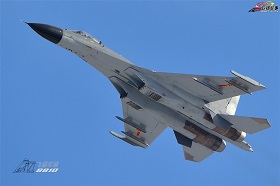
J-11B (unlicensed copy of the Su-27) PLAAF
According to Flightglobal, in 2016 China is in third place after the USA and Russia in terms of numbers of military aircraft, while in terms of numbers of actual warplanes it holds second place by a small margin [7]. In addition to its obsolete aircraft, a major nucleus of modern planes has been created. Its fleet of fighters from the Su-27 family and Chinese copies of them is also probably the biggest in the world.
In recent years the PLAAF has continued to develop rapidly and has entered a new stage in a number of areas. The Chinese air force now faces several serious issues:
- Dependence on arms imports, primarily from Russia.
- The lack of a whole range of aircraft types which are required in modern air forces (for example air-to-air refuelling planes, long-range bombers, large transport aircraft).
- The need to develop capability to project power.
- The need to keep up with technical progress in the military sphere.
Engine manufacturing remains a sore point in the Chinese aircraft industry.
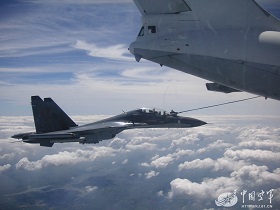
Su-30MKK was specially developed for China
All these issues are closely interlinked.
The question of dependence on Russia is probably the most pressing one for China, driven by memories of the blow that was dealt by the break in relations with the USSR. Not having the opportunity India had to broadly diversify its arms supplies, China has become dependent on a single supplier. Thus the ready-made Su-27s and Su-30s that have been supplied to China, and also the first J-11s built under licence, can only use Russian guided weapons. Despite handing over licences to produce the J-11 with a fairly high degree of localisation, Russia has retained control of supplying a number of components, primarily the AL-31F engines. A modified version of this engine is also fitted to the J-10. The export-oriented J-17, successor to the J-7, uses a variant of the RD-33 engine from the MiG-29.
On the basis of their experience of reverse-engineering Soviet aircraft and their fairly specific attitude to copyright, the decision seemed obvious [8]. And so cooperation with Russia was clouded by “Oriental wile”: the Chinese cancelled their option to buy 95 Su-27s and in 2007 began independent production of an unlicensed copy – the J-11B. Time showed that they were in a rush, because the Chinese WS-10 engine was not ready for front-line use on account of its inadequate time between overhauls, and Russia had refused for some time to supply engines in sufficient quantity to equip the “counterfeit” fighters. However, China later managed to slightly improve the quality of its engines and overcome the conflict situation with Russia, and at least the Su-27 copies are now fitted with Chinese-made engines. A version of the J-10 with a WS-10 engine is undergoing trials, and there are plans to re-equip the JF-17 with an equivalent of the RD-33 too.
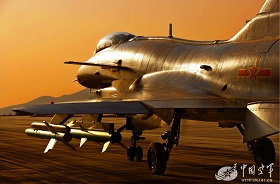
J-10 (based on the Israeli Lavi fighter) PLAAF
However, engine manufacturing remains a sore point in the Chinese aircraft industry. This is evidenced by the fact that prototypes of new aircraft, which China is already trying to create independently, are frequently fitted with Russian engines. There is probably still not enough confidence in the reliability of Chinese-made models.
There is nevertheless a tendency for China to plug the gaps in its air force by its own efforts, even on the principle of “aircraft today, engines tomorrow”. Thus instead of buying the Il-76 China has been developing its own Y-20 transport plane since the mid-2000s – the first prototype, fitted with D-30KP-2 engines, flew in 2013. The WS-18 engine for it (and for other major aircraft) has been in development for a long time. To meet its requirement for airborne early warning and control aircraft, instead of continuing to buy the KJ-2000 installed in Il-76s it is actively expanding the KJ-200 family, installed in Chinese-made Y-8 aircraft.
A multitude of UAVs, including large-scale types, are being developed with an eye to American and Israeli equivalents. One landmark success in this field is the CH-4B UAV, which since 2015 has been operated by the Iraqi air force and is being used in operations against IS terrorists. Trials are also underway for a demonstrator featuring the technology for a future low-signature attack UAV built in flying-wing style, i.e. the equivalent of Western programmes such as the X-47B and the nEUROn [9]. This industry shows clearly that the Chinese should no longer be accused of unthinkingly copying everything that comes along – they are also testing UAVs with no significant Western equivalents, for example large UAVs with a twin-fuselage design or with a ring wing.
Joining the major league
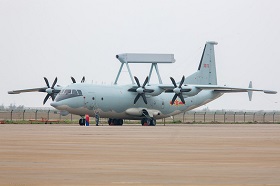
A multitude of UAVs, including large-scale types, are being developed with an eye to American and Israeli equivalents.
The biggest programmes in international military aircraft construction today are aimed at developing a new generation of manned fighters [10]. The only fully-fledged fifth-generation frontline fighter in the world is the American F-22 Raptor. The F-35 Lightning II, which is due to come into service with a whole range of countries close to the USA, including China’s neighbours South Korea and Japan, and probably also Singapore, is gradually completing its testing and is already in serial production. Russia is testing the T-50, which is being created under the PAK FA programme and which will in the future enter into service in India, one of China’s main regional rivals. Other countries also have their own national programmes to develop future fighters, such as Turkey, India, South Korea and Japan (although the financial and technical scale of the challenge means these programmes are progressing very slowly).
In this situation it is no surprise that China is actively engaged in aircraft construction. What is unusual and unique is the fact that China is the only country in the world actively conducting development and flight testing of two fighters at the same time – the J-20 and J-31, which completed their first flights in 2011 and 2012 respectively. The J-31 is still relatively consistent with the stereotype impression of the Chinese aircraft industry, in that it obviously draws inspiration from the F-22 and the F-35, but the J-20 is quite an original aircraft. The late-Soviet MFI programme had a certain influence, but in view of the fact that there were effectively no flight tests of the sole prototype of “Project 1.44” and the programme was frozen at an early stage even in terms of the groundwork, the Chinese have had to do most of the work for themselves.
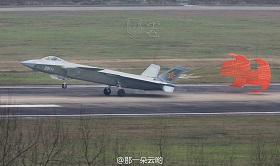
Fifth-generation fighter prototype J-20
There is nevertheless a tendency for China to plug the gaps in its air force by its own efforts, even on the principle of “aircraft today, engines tomorrow”.
The consensus among experts is that the J-20 will probably go into service first with the PLAAF as a heavy strike aircraft/interceptor, and the J-31 is geared towards exports, as a rival to the F-35. It remains an open question whether the J-31 will be procured for domestic needs. Claims that it is the prototype for a carrier-borne fighter look doubtful.
It’s difficult to judge the real progress in the development of Chinese fifth-generation fighters, but at least the J-20 is actively undergoing testing involving nine flying prototypes, including possibly the first pre-production aircraft [11], by the end of 2015. By the end of the decade we should expect full serial production to begin. The fate of the J-31 depends on the search for foreign purchasers and investors.
In order to familiarize itself with Russian experience in this field, last November after protracted haggling China signed a contract to acquire 24 Su-35s, the most modern Russian fighters supplied for export. At the same time Russia managed to insist on terms close to those for the purchases of the Su-30MKK/MK2 – all the aircraft will be assembled in Russia and delivered as finished planes, and there will be no integration of Chinese avionics and weapons. China had earlier insisted on significantly smaller quantities and technology transfer. Its persistence and relative flexibility point up the great interest in the Su-35S, primarily in its engine. Precise copying is unlikely to follow; it’s more likely that it will be used as a “muse” for the development of the J-11 family. Actually, even the Su-30MKK/MK2s were not directly copied, but served as a source of inspiration for the J-16, a two-seat and probably primarily maritime attack modification of the J-11 [12].

Fifth-generation fighter prototype J-31
A multitude of UAVs, including large-scale types, are being developed with an eye to American and Israeli equivalents.
One of the main challenges is the need to transition from an air force geared towards defending the country to one that is capable of striking at strategic distances and undertaking expeditionary operations. The Chinese fleet is actively preparing for such actions and it requires air support. In addition, the air force is actively involved in conflict situations around disputed islands in the South China Sea, and patrolling time in the region is critically important. The construction of artificial islands with airstrips is fairly expensive and does not fully solve the problem.
The generally accepted way of increasing an air force’s range of operation and patrolling time is currently air-to-air refuelling. Thus more than a thousand tanker flights per month are made to keep aircraft of the American coalition in the air in Operation Inherent Resolve [13], and this is not a highly intensive operation. But when it comes to refuelling-tanker aircraft, China is in an extremely difficult situation. The Chinese air force may be the second or third biggest in the world in terms of number of planes, but it’s not even in the top ten for tanker planes. For the many hundreds of fighters and bombers there are just a few Il-86s bought from Russia and tankers converted from obsolete H-6 bombers. Modern tactical aircraft are equipped with air-to-air refuelling systems virtually across the board, but this extremely small number of tankers makes it impossible to support pilots on such a large scale. Moreover, even the newest modifications of the H-6 long-range bombers, the planes that need this most of all, have no air-to-air refuelling system. This puts an additional restriction on the capability of this profoundly modernised 1950s aircraft. Chinese pilots don’t feel confident outside the so-called first island chain, which in theory was supposed to be the outer perimeter of defence for them. Training flights by Chinese aircraft beyond this line have up to now been an event, but maritime communications require defence. Yes, the Chinese navy has a respectable aircraft-carrier programme, but in the first place aircraft carriers are primarily an offensive resource for carrying out expeditionary operations, and secondly, combat-ready aircraft-carrier battle groups are for China something for the fairly remote future. Thirdly, protecting the fleet in “home” waters is still a matter for shore-based aircraft.
In the next few years the PLAAF can be expected to continue work in the above areas. New systems which have been developed entirely by the Chinese themselves will be brought into serial production, and Russia will be seen not as an “air force builder” but as a necessary partner on matters for which they do not yet have enough experience. One of the most complicated challenges will be to reduce the lag behind a navy which is rapidly entering the global arena. However, in the next few years the activity of the fleet as well as the air force will, despite the development of supply points in Africa, be concentrated in the South China Sea. Claims to own islands must be reinforced by a visible presence at sea and in the air, not by the size of an army on the continent.
1. Here and below on matters of history: A. Demin, The Aviation of our Great Neighbour, vol. 2, Russkiye Vityazi, 2012.
2. Or to use its official name, the Republic of China Air Force. The Taiwanese have used the same symbol since the end of the 1920s.
3. The date is frequently given as 11 November, when the General Staff of the PLAAF was set up, but the CCP Central Committee had taken the decision to establish the air force in July. The 1st People’s Squadron was deployed to provide air defence for Beijing on 5 September.
4. The PLA Navy has a large air force of its own, until recently exclusively land-based, including not only specialised anti-submarine patrol aircraft but also conventional fighters and bombers (for example, the Su-30). For simplicity it is not mentioned separately hereafter, and the PLAAF is taken to refer to China’s air force as a whole.
5. It was thanks to one of these clashes that Soviet specialists obtained one of the latest American AIM-9B Sidewinder missiles, which had a great influence on the development of Soviet equivalents and served as the basis for the R-3 family of missiles.
6. After the project was cancelled Israel illegally sold the know-how to China, which is still a sensitive issue in the USA.
7. Such figures should obviously be treated with customary scepticism and not considered totally accurate, especially with a fairly closed country such as China, which has a significant fleet of old planes. Nevertheless, there is no doubt that the numbers of planes in the PLAAF are at least close to those of Russia. It is entirely possible that China may have numerical superiority in a number of aircraft types, for example in fighters.
8. Equipment is also readily copied in other fields, for example motor vehicle manufacturing. A copy of the Hummer, which is procured by the PLA among others, is shamelessly named the Humnee.
9. It is quite ironic that by all accounts this too is fitted with the Russian RD-33 engine.
10. It is worth noting that China counts the generations of jet fighters in its own way, one digit less. Thus for them the Su-27 or J-10 are third-generation fighters, and the F-22A Raptor or the PAK-FA are fourth generation.
11. For comparison, by the same point the PAK FA programme had six.
12. This is indicated by the fact that the J-16 did not feature the changes in the airframe in relation to the base version that there are in the Su-30MKK/MK2, in particular the higher tailfins with a straight upper edge.
13. In 2015 there were 14,737 flights.
(no votes) |
(0 votes) |


